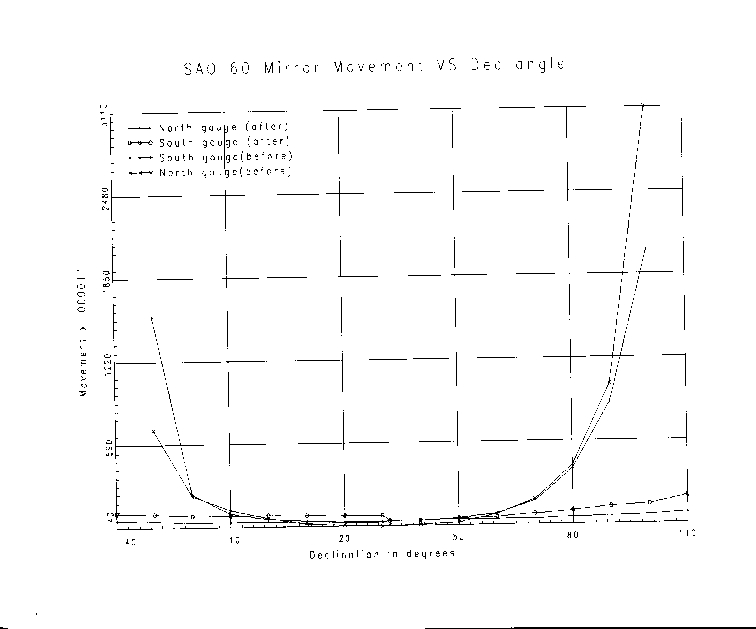Lou Boyd's Memo
Transcribed by EF w/o changes from nearly illegible scan, 08/20/09.
August 11, 1994
Mt. Hopkins, AZ
Memo for Record
Subject: Mirror movement on the SAO 60" telescope
For some time the 60" Tillinghast telescope has had a problem in which the
mirror rises in its cell when the telescope is tilted to zenith angles greater
than about 45 degrees. This problem has been tracked down to an incorrect
balance of forces between the axial counterweights and the axial hard points.
The hard points on this telescope are of an unusual design as they are
internally spring loaded. For pressures of 0 to 75 lbs per hard point
there is no motion. From there to 130 lb force a spring compresses
about 3/8", and at that point further motion is restricted. Apparently
the designers of the hard points did this to protect the mirror from
extreme pressure on the hard points in case of earthquake or other
sudden change of velocity of the telescope (running into something
while slewing?). It is not apparent from inspection of the hard points
that they are spring loaded without disassembly.
Apparently, at some point in time when the telescope was assembled (or the
mirror reinstalled), the mirror was lowered onto the hard points with the
counterweights in a condition which allowed more than 130 lb pressure per
hard point fully compressing the springs. The mirror was then adjusted for
its position in the cell. Near the zenith the telescope will hold position,
but as the force of the counterweights is reduced as the zenith angle
increases, the mirror at some angle will lift, aided by the pressure of the
hard point springs.
The following changes have been made to improve this condition.
1. Identified the existence of the spring loaded hard points and that
they were incorrectly loaded. This was not obvious but one of the original
drawings of the mirror cell showed the spring.
2. The hard points had to be lowered by about 3/8" and the pressure cups on
the back of the mirror were recmented with a 5mm layer of RTV.
3. The force provided by the axial counterweights had to be increased by
about 300 lb total.
4. The position of the mirror in the cell was check and the axial
counterweights set to provide a force in the ratio of 9 on the inside
weights (6) to 10 on the outside weights (12) per information from Bob
Fata. The spring loaded radial hard point was found to be jammed and
was remachined.
Currently the pressure on each hard point is about 45 lb at the zenigh
(it was considerably greater than 130 lb, probably about 200). This
should improve image quality. Test were performed to determine the
remaining movement with zenith angle as shown on the attached
graph. The movement was measured with electronic dial indicators
placed about 3" toward the mirror center of the hard points.
A quick check to determine if the cell is working correctly is as follows:
1. Point the telescope at the zenith.
2. Lift ONE of the inside counterweights. This adds about 90 lb total (30 lb
each) to the hard points. The mirror should NOT move.
3. Lift TWO of the inside counterweights. This adds about 180 lb total (60 lb
each) to the hard points. The mirror SHOULD move.
4. Press the same TWO counterweights down. Note the force required to do this
compared to lifting them. If the forces are the same, then the force on the
mirror is midpoint between the weight of one and two weights
((90+180)/2=135 lb or 45 lb per hard point. This seems like a good compromise
of keeping the mirror in place and mirror deformation.
The situation could be further improved by exactly balancing the
mirror in the cell (adding 135 lb of counterweight force) and
providing the pressure on the hard points using springs which pull on
the mirror very near the hard points. The mirror would have the same
force on the hard point at all attitudes and this should eliminate the
residual motion. If the remaining motion is noticeable this should be
done, otherwise it's not worth the bother.
Louis J. Boyd
SAO 60"/48"
The following still nearly illegible plot accompanied the original.


